AMD’s Radeon HD 6870 & 6850: Renewing Competition in the Mid-Range Market
by Ryan Smith on October 21, 2010 10:08 PM ESTLast but not least in our look at AMD’s new Radeon 6800 series is our look at power consumption, GPU temperatures, and the amount of noise generated. With efficiency being one of the major design goals for Barts, AMD stands to gain a lot of ground here compared to the 5800 series for only a minor drop in performance.
Looking quickly at the voltages of the 6800 series, we have 4 samples – 2 each of the 6870, and 2 each of the 6850. Both of our 6870 cards have an idle voltage of 0.945v and a load voltage of 1.172v, and seeing as how they’re both based on AMD’s reference design this is what we would expect for a design that is based around a single VID.
However our 6850 results, which include a non-reference card in the form of XFX’s customized 6850, are much more interesting. While our reference 6850 has a load voltage of 1.094v, our XFX card reports a load voltage of 1.148v. We’ll be taking a look at the XFX 6850 in-depth next week in our 6850 roundup, but for now this leaves us with the question of whether AMD is using variable VIDs, or if XFX is purposely setting theirs higher for overclocking purposes.
| Radeon HD 6800 Series Load Voltage | |||||
| Ref 6870 | XFX 6870 | Ref 6850 | XFX 6850 | ||
| 1.172v | 1.172v | 1.094v | 1.148v | ||
Finally our EVGA GTX 460 1GB FTW card has a VID of 0.975v, which compared to all the other GTX 460 cards we’ve tested thus far makes it quite notable. This is lower than any of those other cards by 0.012v, a property we believe is necessary to sell such a heavily overclocked card without causing a similarly large rise in power/heat/noise. It’s also for this reason that we question whether NVIDIA could actually supply suitable GF104 GPUs in high volumes, as GPUs capable of running at this voltage are likely coming from the cream of the crop for NVIDIA.
For our tests, please note that we do not have a pair of reference 6850s. For our second 6850 we are using XFX’s customized 6850 card, which means our results will undoubtedly differ from what a pair of true reference cards would do. However as the 6850 reference design will not be widely available this is less important than it sounds.
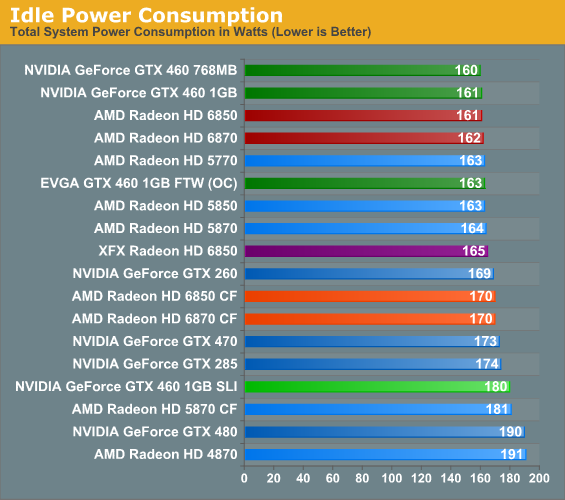
As always we start our look at power/temp/noise with our look at idle power. Because we use a 1200W PSU in our GPU test rig our PSU efficiency at idle is quite low, leading to the suppression of the actual difference between cards. But even with this kind of suppression it’s still possible to pick out what cards have a lower idle power draw, as the best cards will still result in a total system power draw that’s at least a couple of watts lower.
AMD’s official specs call for the 6800 series to have a lower idle power draw than the 5800 series, and while we can’t account for all 8 watts we do manage to shave a couple of watts off compared to our 5800 series cards. The Crossfire results are even more impressive, with the 6870CF drawing 11W less than the 5870CF.
Compared to the 6800 series the GeForce GTX 460 768MB does manage to hang on to top honor here for a single card by a watt, however in SLI our 1GB cards do worse than our 6800 series cards by 10W.
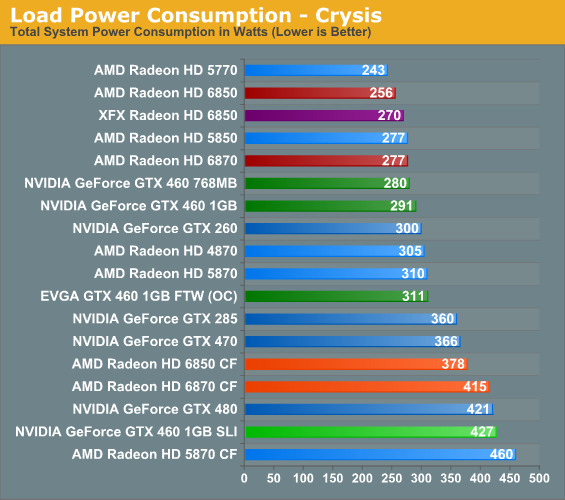
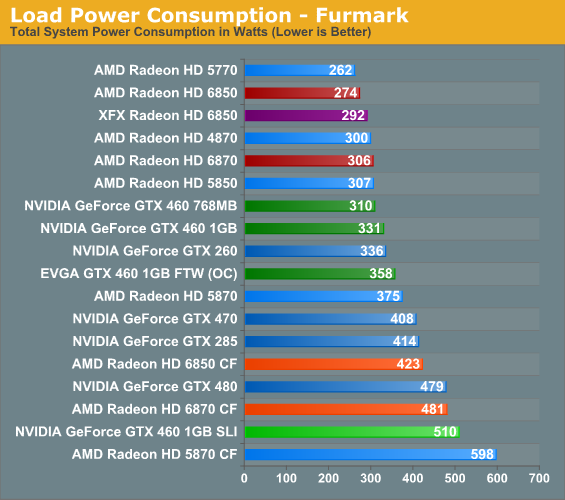
Looking at load power consumption it’s clear from the start that AMD’s efficiency gains are going to pay off here. On the latest iteration of our power consumption chart the 6850 underconsumes even the already conservative 5850 by 20W under Crysis and 25W under FurMark, showcasing how AMD was able to reduce their power consumption by a significant amount while giving up much less in the way of performance.
Compared to the 6800 series NVIDIA does notably worse here, with all of the GTX 460 cards pulling down more power than the 6870 and the GTX 470 being in a league of its own. While NVIDIA was competitive with Cypress on power, they’re not in a position to match Barts. They can deliver Barts-like performance (and then some), but they have to consume more power to do it.
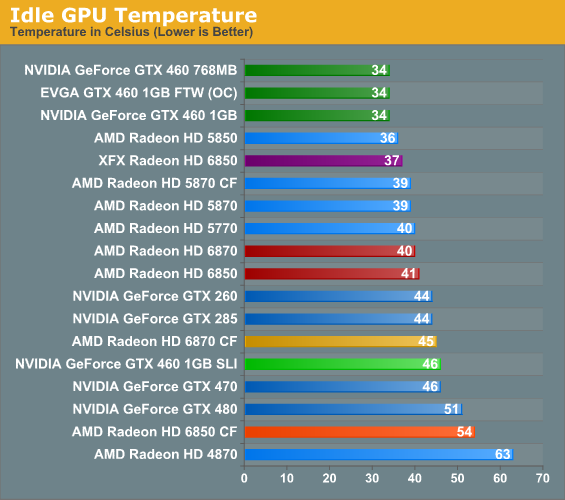
Up next is our look at GPU temperatures, starting with idle temps. As we mentioned in our GTX 460 review, NVIDIA ended up producing a very effective reference cooler for the GTX 460, utilizing an open-air design that by dissipating air inside and outside of the case is capable of reaching temperatures fully exhausting coolers can’t match. As a result all of the GTX 460 cards top our charts here.
Prior to the GTX 460 series this is a metric the 5850 always did well in, so we had expected a similar performance from the 6850, only to leave disappointed. What we’re ultimately looking at is a matter of the quality of the cooler: the 6850 may consume less power than the 5850 at idle, but it packs a weaker cooler overall, allowing it to approach these temperatures. For a gaming card such as the 6800 series idle temperatures are almost entirely superficial once we get below 50C, but even so this tells us something about the 6850 reference cooler.
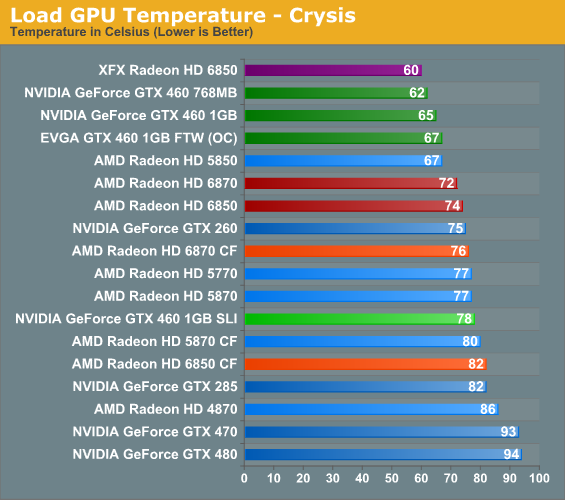
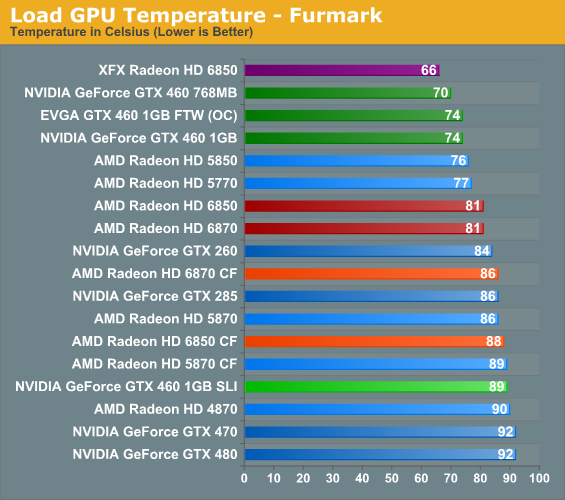
Thanks to the GTX 460’s open-air cooler, all of our GTX 460 cards top our temperature chart even with their higher power consumption. The trade-off is that all of these cards require a well-ventilated case, while the Radeon 5800 and 6800 series will tolerate much poorer cases so long as there’s enough ventilation for the card to pull in air in the first place.
As was the case with idle temperatures, the reference 6850 ends up doing worse than the 5850 here thanks to its less effective cooler; however the 6870 ends up doing better than both the 6850 and 5870 due to its more effective cooler and its lower power consumption compared to the 5870. While these cards can’t quite touch the GTX 460 series, we’re still looking at some of the coolest cards among our current benchmark suite.
Meanwhile our XFX 6850 ends up doing the best out of all of our cards here, however this will come at a cost of more noise. We'll touch on this more next week in our 6850 roundup.
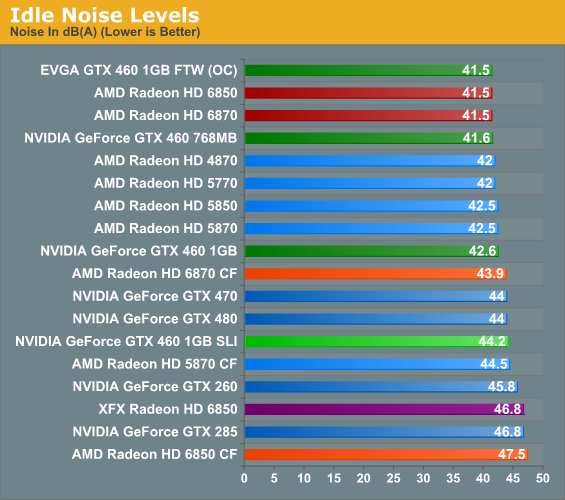
Last but not least is idle noise, which isn’t much of a story with modern cards. With the exception of the GTX 470/480, the latest GeForce and Radeon cards are both capable of running up against the noise floor of our testing environment.
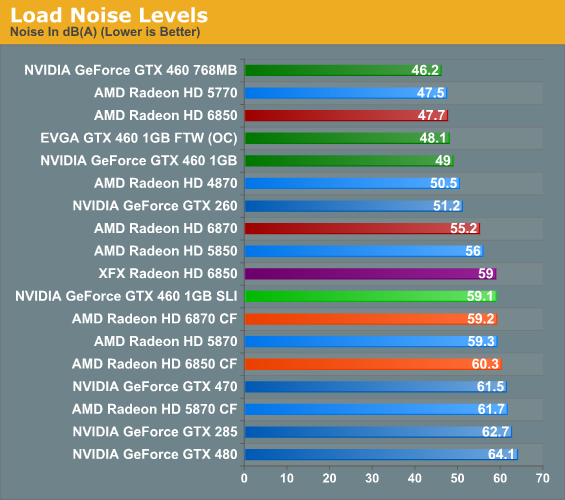
Under load we once again see an NVIDIA GTX 460 card top the chart thanks to its open-air design. This is followed very closely however by the Radeon 6850, which at 47.7dB is our third-quietest card and finally showing off the advantages of the tradeoffs AMD made with the reference cooler. The 6850 may not be as cool as the 5850, but it’s quite a bit quieter. As for the XFX card, this is where XFX has to pay the piper, as their 6850 card ends up being as loud as a 5870 in exchange for their lower temperatures.
Meanwhile the 6870 ends up being quite a bit louder than both the GTX 460 series and the 6850, coming in at 55.2dB. This is a definite leg-up compared to the 5870 and nicely cements the fact that the 6870 is intended to be the 5850’s replacement, but it means the GTX 460 series spoils the results here. Once custom-design vendor cards come out for the 6870, I suspect we’re going to see someone quickly sell a 6870 with a less aggressive cooler, which for the costs of higher temperatures would afford less noise.










197 Comments
View All Comments
StriderGT - Friday, October 22, 2010 - link
I agree with you that the inclusion of the FTW card was a complete caving and casts shadows to a so far excellent reputation of anandtech. I believe the whole motivation was PR related, retaining a workable relation with nvidia, but was it worth it?!Look how ugly can this sort of thing get, they do not even include the test setup... Quote from techradar.com:
We expected the 6870 to perform better than it did – especially as this is essentially being pitched as a GTX 460 killer.
The problem is, Nvidia's price cuts have made this an impossible task, with the FTW edition of the GTX 460 rolling in at just over £170, yet competently outperforming the 6870 in every benchmark we threw at it.
In essence, therefore, all the 6870 manages is to unseat the 5850 which given its end of life status isn't too difficult a feat. We'd still recommend buying a GTX 460 for this sort of cash. All tests ran at 1,920 x 1,080 at the highest settings, apart from AvP, which was ran at 1,680 x 1,050.
http://www.techradar.com/reviews/pc-mac/pc-compone...
oldscotch - Friday, October 22, 2010 - link
...where a Civilization game would be used for a GPU benchmark.AnnihilatorX - Friday, October 22, 2010 - link
It's actually quite taxing on the maps. It lags on my HD4850.The reason is, it uses DX 11 DirectCompute features on texture decompression. The performance is noticeably better on DX11 cards.
JonnyDough - Friday, October 22, 2010 - link
"Ultimately this means we’re looking at staggered pricing. NVIDIA and AMD do not have any products that are directly competing at the same price points: at every $20 you’re looking at switching between AMD and NVIDIA."Not when you figure in NVidia's superior drivers, or power consumption...depending on which one matters most to you.
Fleeb - Friday, October 22, 2010 - link
I looked at the load power consumption charts and saw the Radeon cards are better in this department and I don't clearly understand your statement. Did you mean that the nVidia cards in these tests should be better because of superior power consumption or that their power consumption is superior in a sense that nVidia cards consume more power?jonup - Friday, October 22, 2010 - link
I think he meant the nVidia has better drivers but worse power consumption. So it all depends on what you value most. At least that's how I took it.zubzer0 - Friday, October 22, 2010 - link
Great review!If you have the time I would be wery happy if you test how well these boards do in Age of Conan DX10?
Some time ago you included (feb. 2009) Age of Conan in your reviews, but since then DX10 support was added to the game. I have yet to see an official review of the current graphics cards performance in AoC DX10.
Btw. With the addon "Rise of the godslayer" the graphics in the new Khitai zone are gorgeous!
konpyuuta_san - Friday, October 22, 2010 - link
In my case (pun intended), the limiting factor is the physical size of the card. I've abandoned the ATX formats completely, going all out for mini-ITX (this one is Silverstone's sugo sg06). The king of ITX cases might still be the 460, but this is making me feel a bit sore about the 460 I'm just about to buy. Especially since the 6870 is actually only $20 more than the 6850 where I live and the 6850 is identically priced to the 460. There's just no way I can fit a 10.5 inch card into a 9 inch space. The 9 inch 6850 would fit, but there's a large radiator mounted on the front of the case, connected to a cpu water cooling block, that will interfere with the card. I've considered some crazy mods to the case, but those options just don't feel all that attractive. The GTX460 is a good quarter inch shorter and I'm getting a model with top-mounted power connectors so there's ample room for everything in this extremely packed little gaming box. I'm still kind of trying to find a way to put a 6850 in there (bangs and bucks and all that), which leads to my actual question, namely:The issue of rated power consumption; recommended minimum for the 460 is 450W (which I can support), but for the 6850 it's 500W (too much). How critical are those requirements? Does the 6850 really require a 500W supply? Despite having lower power consumption than the 460?! Or is that just to ensure the PSU can supply enough amps on whatever rail the card runs off? If my 450W SFF PSU can't supply the 6850, it really doesn't matter how much better or cheaper it is ....
joshua4000 - Friday, October 22, 2010 - link
let me get this straigt, fermi was once too expensive to manufacture due to its huge die and stuff but its striped down versions sell for less and outpace newley released amd cards (by a wide margin when looked at the 470)amds cheaper to manufacture cards (5xxx) on the other hand came in overpriced once the 460 had been released (if they havent been over priced all along...), still, the price did not drop to levels nvidia could not sell products without making a loss.
amd has optimised an already cheap product price wise, that does not outperforme the 470 or an oced 460 while at the same time selling for the same amount $.
considering manufacturing and pricing of the 4870 in its last days, i guess amd will still be making money out of those 6xxx when dropping the price by 75% msrp.
NA1NSXR - Friday, October 22, 2010 - link
Granted there have been a lot of advancements in the common feature set of today's cards and improvement in power/heat/noise, but the absolute 3D performance has been stagnant. I am surprised the competition was called alive and well in the final words section. I built my PC back in 7/2009 using a 4890 which cost $180 then. Priced according to the cards in question today, it would slot in roughly the same spot, meaning pretty much no performance improvement at all since then. Yes, I will repeat myself to ward off what is certainly coming - I know the 4890 is a pig (loud, noisy, power hungry) compared to the cards here. However, ignoring those factors 3D performance has barely budged in more than a year. Price drops on 5xxx was a massive disappointment for me. They never came in the way I thought was reasonable to expect after 4xxx. I am somewhat indifferent because in my own PC cycle I haven't been in the market for a card, but like I said before, disappointment in the general market and i wouldn't really agree with the statement that competition is alive and well, at least in any sense that is benefiting people who weight performance more heavily in criteria.